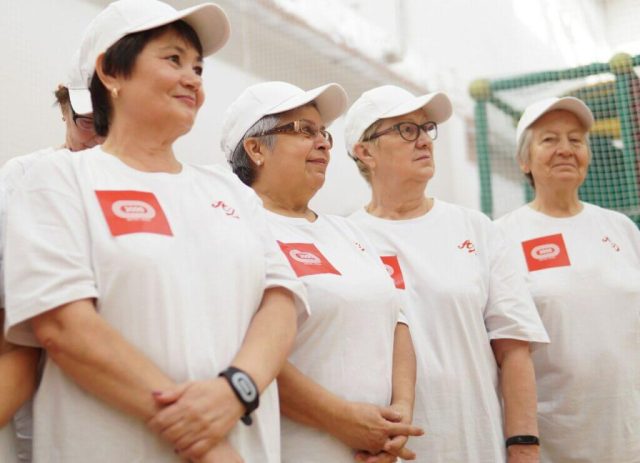The benefits of regular fitness for people over 50

It’s no secret that with age, each person’s body and mind change. Physical changes are manifested in the fact that the muscles gradually decrease in size, and this leads to a weakening of the body, the development of uncertain coordination and other negative consequences.
This phenomenon in medical practice is called “sarcopenia”. The calf and quadriceps muscles suffer the most from it. Numerous studies indicate that in seventy-year-old people they are almost twice as weak as thirty-year-olds.
This situation is considered one of the most important problems of modern medicine, because these changes in the body inevitably cause a decrease in the overall quality of life, often creating insurmountable obstacles to solving the basic functional tasks facing a person. Today, there are many different medications, types of special nutrition that are designed to combat muscle withering.
However, studies show that they only become effective when used in combination with physical activity. That is why fitness is not just a fashionable activity for the elderly, but also an extremely relevant resource for improving health. Properly selected by specialist physical exercises, which are regularly performed for three to four months, already give a positive result.
Benefits for the Elderly
Adherence to the principles of a healthy lifestyle, combined with adapted fitness, has a double positive effect on older people: they contribute to the improvement of both physical and mental condition.
Positive changes in the body are manifested in the following:
- metabolism is accelerated. With age, the metabolic process inevitably slows down, which causes numerous diseases in old age. Moderate physical activity can significantly speed up metabolic processes;
- visceral fat, accumulated in the abdominal cavity and interfering with the normal functioning of internal organs, is burned more actively. Physical exercises make it possible to get rid of it, and turn the substances entering the body into muscle mass;
- immunity is strengthened. A passive lifestyle always accompanies the accumulation of various chronic diseases. Fitness under the supervision of a doctor helps to strengthen the immune system;
- the joints are significantly strengthened. Regular physical exercises ensure that the entire coordination system of the human body, flexibility, and balance are maintained in good shape. Fitness is an excellent prevention of arthrosis and arthritis;
- improves the performance of the heart muscle. Minor and controlled physical activity normalizes blood circulation in the muscles, contributing to the strengthening of bones.
Fitness is also useful for strengthening the mental sphere, this is manifested in the following:
- helps to cope with insomnia. Insomnia is one of the most common problems in older people. It affects both the general mental and physical state. Properly developed with the participation of a doctor, complexes of physical exercises can quickly eliminate insomnia, make sleep more healthy and deep. Waking up after fitness classes charges older people with vigor and energy;
- contributes to the production of endorphins – the hormone of joy, which is responsible in the body for a person’s mood and his psycho-emotional state;
- Helps keep brain function active. With regular fitness classes in the elderly, neural activity, memory, and cognitive abilities are perfectly preserved.
Fitness is an effective antidepressant, especially if exercise is organized in a peer group.
What problems does fitness solve in the elderly?
Physical activity for the elderly can solve a wide range of medical problems. Through fitness:
- the muscular system is strengthened;
- metabolism is accelerated;
- maintains the elasticity of ligaments and joints;
- slows down the development of osteoporosis;
- coordination and functioning of the vestibular apparatus improves;
- body weight decreases;
- normalizes blood pressure;
- immunity increases;
- improves psycho-emotional state and tone;
- improves the functioning of the respiratory system and the cardiovascular system;
- the level of pain decreases;
- cerebral circulation is maintained at a normal level, etc.
To achieve these results, older people are advised to practice:
- cardio to strengthen the heart muscle. Exercises specifically designed for this, as a rule, include the same type of simple movements that involve the muscles of the lower and upper parts of the body. When they are performed, there may be some increase in breathing, which is quite normal and is associated with an increased flow of adrenaline into the blood. Such fitness may include slow walking, the same cycling, slow dancing, calm climbing stairs, etc .;
- strength exercises that help increase endurance, reduce fatigue and eliminate shortness of breath. As practice shows, strength training of the elderly contributes to an increase in vital activity. Classes include repetitive exercises on simulators, with dumbbells, sports elastic bands and other equipment;
- exercises for coordination and flexibility. Such fitness includes a wide range of various movements that help you confidently control your own body, maintain muscle tone at a high level, and avoid injuries in everyday life. Flexibility exercises may include elements of yoga, tai chi, and movements to improve posture and strengthen the spine.
It is quite acceptable for people of fifty years of age to do fitness for one hour, the elderly under 65 years old can do it for 35-40 minutes, and if the age has exceeded 75 years, then 25 minutes is the maximum time for exercise. Classes should not be aimed at achieving any kind of sports results. Complexes of exercises are coordinated with the doctor. They should be performed in a strictly individual rhythm and in the most comfortable environment.